#show me the concept sketches
Explore tagged Tumblr posts
Text
Gosh, the Bug’s Life bloopers have permanent residency in my halls of affection.
I’ll humbly submit to add movie making/BTC and director/actors commentaries. I’ve seen this movie so many times, can I get a little salt? And little pepper? And tsp. of chili flakes? Perchance to dream of some aardvark sauce?
Two things it should be illegal to make DVDs without: Bloopers and Deleted Scenes.
#show me the concept sketches#give me footage of the orchestra recording the soundtrack#I absolutely crave taking inside jokes that were left to die on a set and putting them up in a spare bedroom#I love having behind the scenes trivia to agonize over if it would be annoying to share with people#I have a friend who likes to either bops me on the head and says SNOOZE! or whisper to me You’re almost out of the friend group#I need to pick my battles and choose my fan trivia carefully#which means I need quality content to choose from#lest I be out of the friend group 💔#(it’s my brother)#(he can’t actually ditch me)#(but I do run the risk of being snoozed)#film#movie making#dvd Easter eggs#a previously superior experience#would you like a thoughtfully designed dvd menu with hours of content that teaches you what it actually takes to make a good movie?#or would you like to be able to watch almost anything anytime with terrible quality on mute on a tiny screen while you’re on the bus?
1K notes
·
View notes
Text

go shawty its yo birthday
#happy birthday birfday birday#happy birthday to me and me onlyyyyyyyyyyyyyy#we're 23 now!#i do a new self portrait every year to to show how much i've grown as an artist and to practice a new concept#this year was lighting!#sorry i havent been active here on tumblr its been a wild few months#soon ill do this big art dump for everything yall missed#but if you dont wanna wait for that you can check my twitter for my latest work#anyway birf#art#originalcharacter#originalartwork#sketch#self portrait#birthday art#pali draws
211 notes
·
View notes
Text
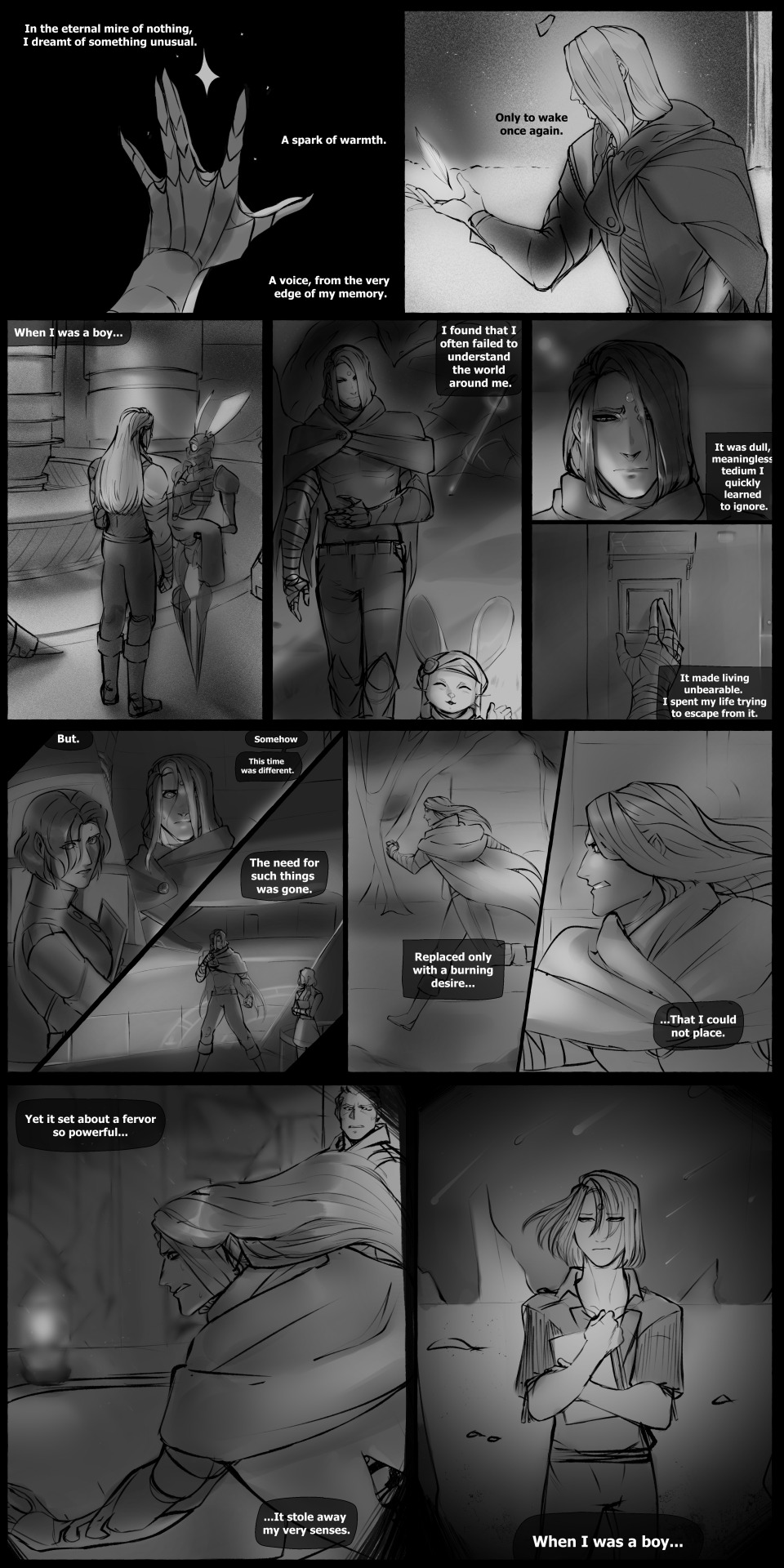
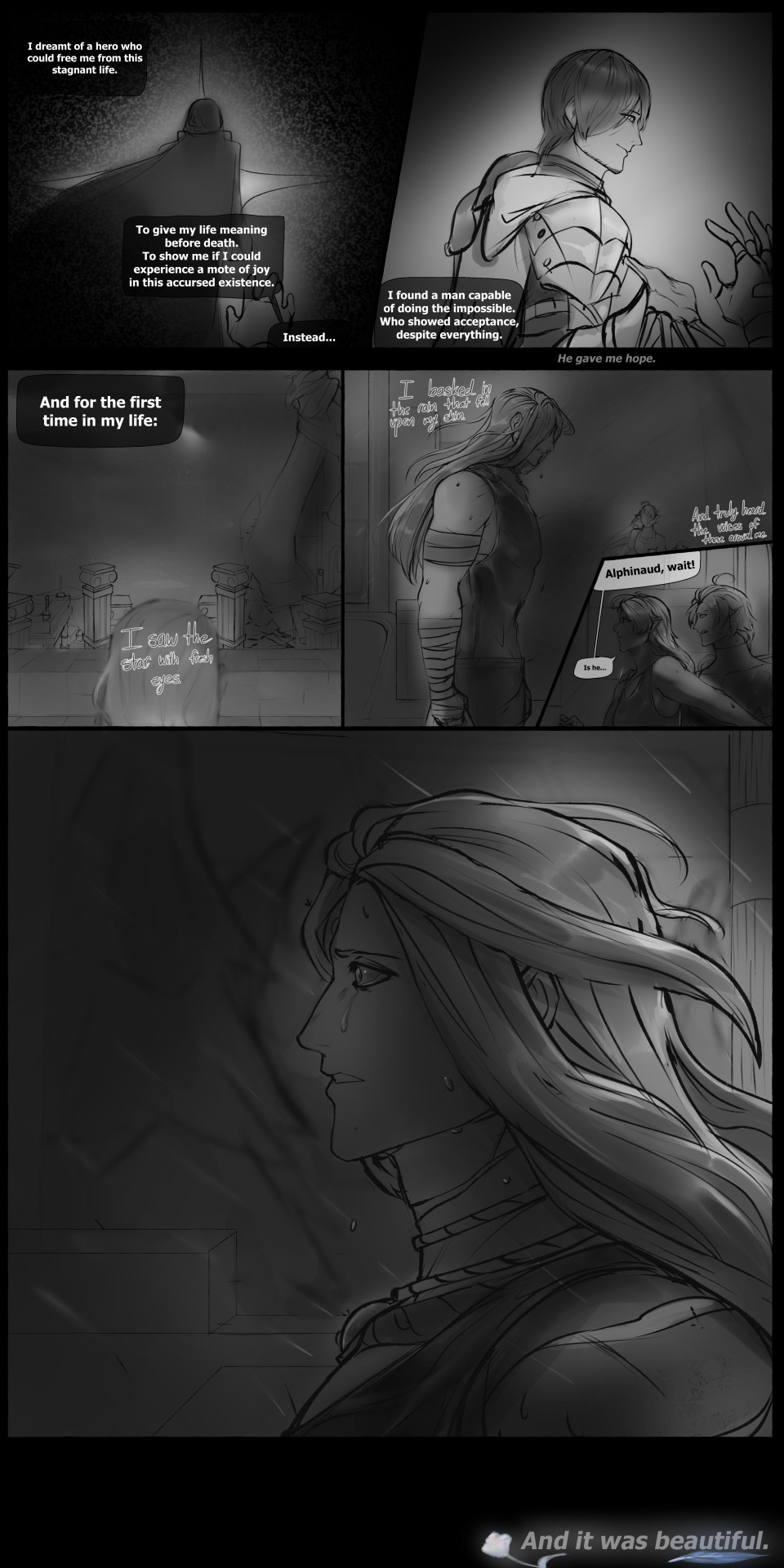
Finally I can post the comic for Adventurer!Zenos that has taken hold of my brain for the past week.
AKA a man who is currently running off the fumes of the literal souls of the damned being very desperate to be out of the void he was stuck in (and for the first time actually being able to just enjoy something mundane), only to get absolutely overwhelmed but all the stimuli he had just... ignored until now.
#ffxiv#concept#sketch#comic#zenos yae galvus#adventurer!zenos#meteor survivor#I will admit I find a lot of enjoyment writing antagonists that show a capacity for change#its a part of the reason psaro and hendrick are some of my favorite dragon quest characters LOL#the fact alisaie lives in this man's head rent free pushed me to do this#so i wanted to do a bit of a character study exercise trying to work on this man's motivations#I am so sorry I have so much brainrot about this man#if any of you saw Tsukiko standing outside the forum for like 6+ hours over several days#it was because I was dying inside trying to draw the overlook of the ocean and the statue of thaliak#perfectionism kicks my ass when it comes to backgrounds lmfao
178 notes
·
View notes
Text

rough concept for the cutscene before the last phase of the final fight; in a desperate attempt to avoid being imprisoned again (despite zelda not wanting that) he snatches the enigma stone and transforms, wrecking havoc on the ground before going for link and zelda (i like to think that a sudden transformation like that, especially when wounded, doesnt make you immediately all in control so hes kinda .. writhing in pain on the ground for a few seconds at least)
the stone is located inside of him instead of on his head again somehow and at the end of the fight link will have to fall straight into his maw to reach it and use the remedy to remove it and reverse the transformation (not gonna go into full detail again but im trying really to make it work in the most sensical way)
(totk rewritten project)
#ganondoodles#zelda#art#ganondoodles rewrites totk#ganondorf#technically#i know sketches like these with the lines still there wont gather as much attention#but they are easier to do for me#they are still just concepts after all#and i know zelda games are really afraid to show any kind of blood or actual open wound#but this is my territory now so i get to decide that#anyway i found the image of him writhing around on the ground uncontrolled for a little bit really impactful#like to show hey that transformation thing isnt anything you should do actually
464 notes
·
View notes
Text
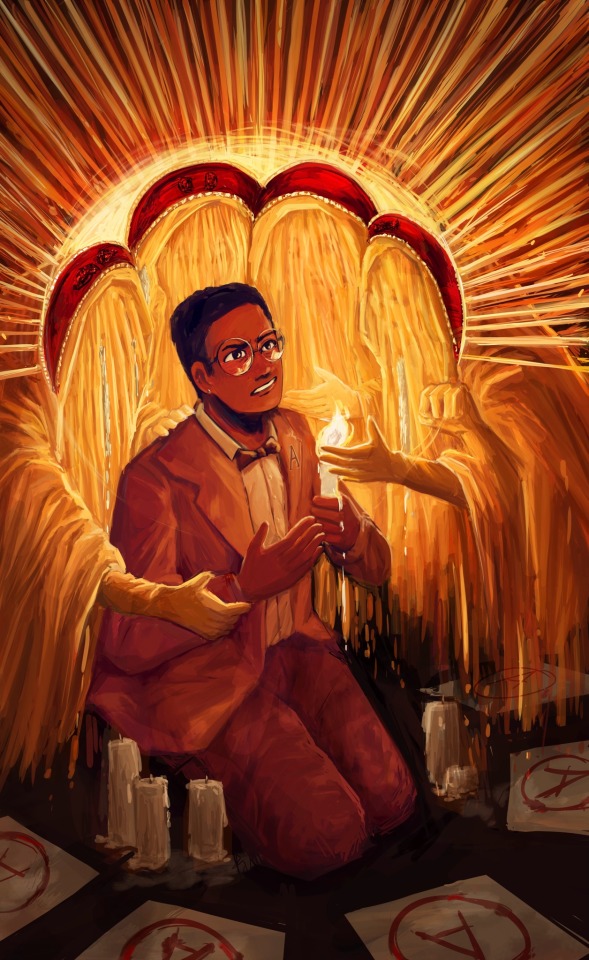
litany of the martyrs (click for better resolution!)
#at some point i wanted to make an illustration for each character but in retrospect maybe each is multiple song-coded..#drew the sketch for a quincy thing after a chat with a mutual reminded me this song existed dfsghjkl and then spent weeks rendering this#quincy cynthius martin#adamandi#i'm finally done with this! the saints especially were joys to paint and the halo a menace.... this has been the most ambitious one so far.#but it also took quite long because i only worked on it <engages with quincy> when mentally okay to deal with the themes. i'm not religious#but i do identify with the irrational(?ish) guilt + family legacy + academic achievement + disregard for self. also more complex thoughts#about love [but depsite quincent being a large part of quincy's character this piece deals with mostly the Rest of it. so another time..]#anyways! in the original sketch- the saints had heads bent towards quincy so the halo spikes pointed at him. but this worked better! halos#of the saints implying/creating one for quincy was a concept from the start though. in the show they don't touch him directly here but#differences in mediums i think- i don't have time in an image to craft a narrative so everything has to be happening. also artistic liberty#misc inspiration for this includes stained glass windows. i might have maybe misinterpreted the saint costume but i think i logic-ed it out#as the cloth part following a nun's habit w the hood. and then halo above. the material is also more transparent originally but i had. um.#too much fun painting fabric folds.. if you look closely you can see the basis of faces though behind the cloth; but only the vague shapes#because smth obscurity + inhumanness// cassian is the only one i gave a mouth though. that stems from melliot's post about the saints and#st cassian as spokesperson (<- did research teehee!) that's also how i found out which costume = which saint. speaking of which.#left to right: 'st lucy take my hand' // 'st lawrence give me strength' (presses quincy forward; but hand on shoulder connotates guidance)#/'st cassian help me smile' (quincy's mouth is btwn a grimace and a smile; tilts up at side. also no direct touch bc added insidiousness.)#//'st jude [...] i hope your causes burn' (jude's hand is in two places to show movement- nearing the flame and then snatching back; burnt)#other notes: at the midst of the flame the core is shaped like a human heart /the saints and their wax are all melting like the candle for#fun visual effect and also this way they are even less tangible <real>. perks of painting as a medium i guess. // also insp from icarus?#wax and burning imagery; looking at the halo and rays as parallel to sun that burns. too close to the sun; melting; hurting; hurtling //#candles at bottom are a nod to the frankly gorgeous set// also the entire composition kind of stems from the lyric <what use is a candle if#both ends aren't burning>; the two sides between the concepts of catholic guilt and academic perfection that spur quincy#the halo above (saints and guilt; litanyofthemartyrs) and the 'halo' below (academic papers; insp from choreo for perfect at school)#the papers were originally supposed to be more glowy. but i like the idea of it now being a reflection of how quincy's priorities shift#also of note is that <candle> in centre = quincy; w burning candle + aforementioned heart in flame -> most human; idea of love + passion#last thoughts: kneeling + hands close tgt = prayer //wax dripping onto the red As make an effect that looks like blood. because i like#hiding that within the adamandi pieces :OO continuity!! // i've run out of tags but yeah! had fun with this one! every so often i go a#little insane in making art and the final result astounds even me. ngl i'm quite proud of this one. pretty colours <3333
355 notes
·
View notes
Text





i had a nap at a horrible hour and now i cant sleep so have these. scurries off
#winter is fun but GODDD does it drain my emotions and deplete my motivation#anyways various eggs and 2 guys i havent shown here yet. i have some digital sketches but i havent completed their colours yet#so i dont wanna show em off or anything yet#a friend gave me the ideas for toybox-tart and goodra-tart BOTH. So good tarts…#the sketches of toytart and gootart here are concepts. i wanna draw those forms both digitally when i can#ALSO COWTART. see it#myart
48 notes
·
View notes
Text
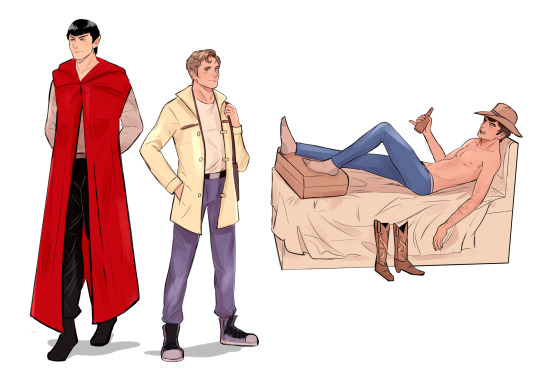

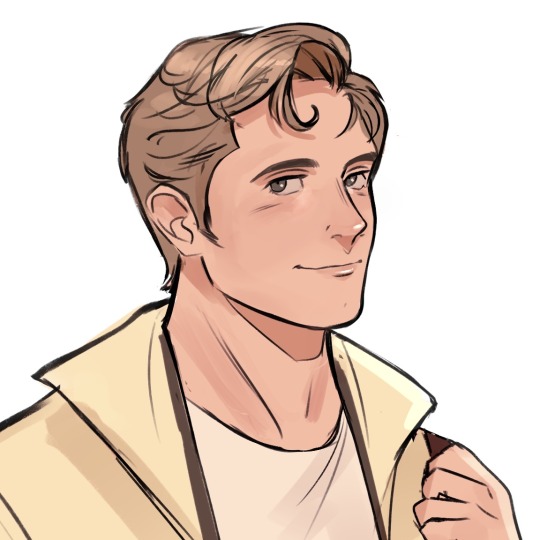

@dig-jules 👀😩
#star trek#star trek academy#st tos cadets#linking the og post that inspired me :)#I prolly fucked up the concept sketches…they were too blurry so I just guessed what they were trying to show 🤠#yeah no I fucked up the outfits 😭#damn…imagine if we got this au irl smh#james t kirk#s'chn t'gai spock#leonard mccoy#captain kirk#commander spock#doctor bones#jim kirk#spock#star trek fanart#spirk#k/s#star trek tos#st tos young crew
823 notes
·
View notes
Text



*shoots your doomed yaoi with a doomed yuri beam*
Sailor Trigun at ALA!!!
#I’m so happy with how these cosplays came out they look just like my concept sketches#and I’m genuinely surprised so many ppl realized what we were!#most ppl thought it was just fem vashwood but a lot of ppl knew it was magical girls specifically I’m v happy#hopefully will have milly Meryl photos from ala to show soon#patiently waiting on those from the photographer#bunny sewed me a new longer cape with a better collar and I remade my undershirt for her#ala changed their prop weapon rules mid con tho which was v sad bc I hand painted and made customized stickers for her milly gun all week#and then they stopped allowing any prop guns that weren’t 50% orange :(#we were able to bring it to the Trigun meetup luckily bc it was outdoors but not to our shoot#next time ig!!!#my cosplay#Trigun#sailor moon#pgsm#vashwood#sailor Trigun#magical girls#vash the stampede#Nicholas d wolfwood#what did I name these au guys#sailor gunsmoke#sailor hopeland#???#i think#Trigun maximum#Trimax#cosplay#au#ala 2024#anime los angeles
187 notes
·
View notes
Text

So as it turns out I doodled a parody cover concept of "The Great Gatsby" with Bill Cipher way back in 2015 (see far right top corner for date of my notes)... does this mean I was ahead of the curve? :3c
#i have Never read the book. i think the teacher showed us a book cover for it that fsr gave me bill vibes#so entirely lucky concept done by chance given tbob#art#old art#sketches#the book of bill#tbob#book of bill#gravity falls#bill cipher#fanart
21 notes
·
View notes
Text





Bunny blanc sketches forrrrr uhhhhhh something ;3
Kind of embarrassed about how much I've always liked her since I was a little kid BUT!!!!!!!!! I WON'T BE FOR LONG!!!!!!!! BUNNY BLANC I LOVE YOU AND I PLEDGE MY ALLEGIANCE TO YOU, YOU'RE DREADFULLY NEGLECTED CHARACTER, AND ALL YOUR MISSED POTENTIAL!!!!!!!
#she is ohhhhhhh god she's everything to me#fuckkkk ARRGGRGRGRHRHRHHRHRHHHH FOR TGE PAST FEW NIGHTS IVE BEEN COMPLAINGIGN TO MY SISTER ABOUT HOW#THE ONLY MINISODE WE GOT THAT FOCUSED ON ALISTAIR AND BUNNY OUTSIDE OF WTW AND SPRING UNSPRUNG#WAS ABOUY THEIR DRY BARELY EXPLORED RELATIONSHIP WITH EACHOTHER#ARHRGRGRGGRGDHDHDBBRBDHRHDBHDHHH#i can fix her guys dw#i loved her character concept and character design soooo much......... i STILL DO WHAT AM I TALKING ABOUT?!???#i loved her airy voice#her timid mannerisms#they showed her being a bit of a bitch out of jealousy#and YASSSSSSSS THATS SO REAL. I CAN WORK WITH THIS. I CAN DRILL INTO THAT AND MOLD A FULLY DEFINED CHARACTER OUT OF HER#SHE DESERVES IT#SHE DESERVES BETTER#also i find it hilarious that i basically drew her with the same “done with this” “exhausted” mellow kind of look in every single one of#these sketches#eah#ever after high#eah redesign#?#bunny blanc#wonderlandians#tea art 🎨#oklo makes a post
18 notes
·
View notes
Text


Made a new ref sheet for my ebverse self, and made a dramatic portrait as well :D
#My art#Ebverse#all this time my sona has had shapeshifting powers and I've never shown what he can turn into!#but i've finally decided on what it is (some kind of anthro hellhound - aka one of my fursonas lmao)#i've got some concept sketches of it but i'm waiting to show it when i have a final design.. which will hopefully happen soon-ish#Me#My sona#Mav
28 notes
·
View notes
Text
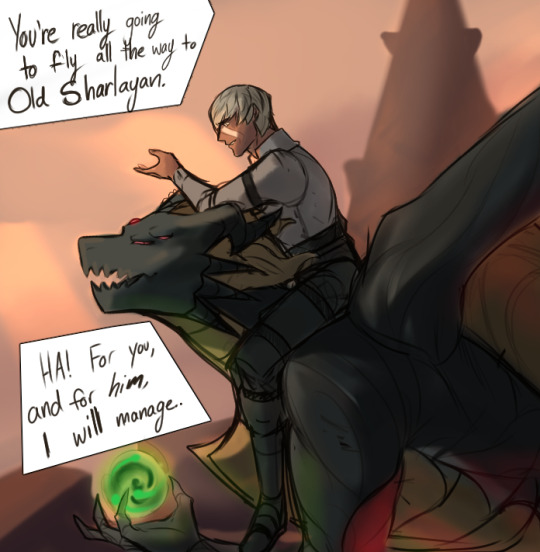
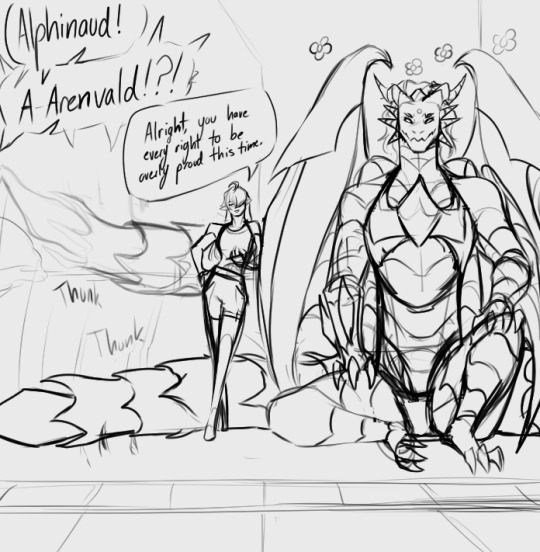
he is indeed very proud of himself.
#ffxiv#sketch#concept#zenos yae galvus#adventurer zenos#arenvald lentinus#zenos but he ends up finding immense satisfaction in helping others attain their goals the more he starts paying attention to others#and a reason to actually focus on his own intense curiosity and penchant for research#AND using his ability as the ultimate hype man to inspire people#tmw something you say just to cope with your situation gets followed up on#>arenvald- while dealing with the absolute fuckton of hills and stairs in ala mhigo#>zenos- putting himself in heavy tataru debt just to kidnap cid and nero for some new experimental magitek inventions#tbh this spawned from just some of my own writing with atticus and his own prosthetics- and#the really cool exoskeletons ive seen for like- combat mech suits for arenvald#it also just makes me think of the terrifying concept that an aware zenos would always be listening- and always attentive#which tbh honest even with just fordola and yotsuyu back in and before StB feels like almost fae curse levels#those situations- but he's actually invested in their intended outcomes#grueling months of PT and perseverance in exchange for being able to surprise your best buddy with you being able to stand#and also walk short distances so he can actually show you around his hometown
48 notes
·
View notes
Text
People asked so I’m just posting this rough sketch as proof of concept so I don’t forget about it lol
Basically the premise of the AU is Home ends up Possessing Wally’s body and pretends to be him so he can replace Wally, while the entire time Wally himself is trying to get Home to trip up in-front of his friends so they can realise what Home’s doing
Wally is still able to see everything just not interact (like a ghosts only Home can see/hear)
Well, kinda
He can still eat things with his eyes for plot reasons

Anyway, just a rough idea, not really fully planed out yet and kinda bad but I hope it at least interests you
Pits called the Eviction AU btw cause home evicts Wally from his own person and I thought it was a funny pun
#art#my art#quick sketch#rough sketch#welcome home#welcome home puppet show#I’ve been informed Clown doesn’t like it being referred to as an arg so I won’t be doing that anymore#wally darling#wally darling angst#welcome home wally#welcome home home#Eviction AU#welcome home eviction au#rough concept#welcome home au#if I see a single one of you being gross about welcome home I will block you#also if clown wants me to take this down I’ll be happy to dw
221 notes
·
View notes
Note
No no ikr. The ENT fandom is so quiet around here. And honestly I'm just excited to see art of my favourite dudes, because we rarely get fanart around here, and when we do it's usually Trip or T'Pol solely. Malcolm gets left in the dust quite a lot so I'm happy you drew him as well - and so well done too!
Anyway, ramble over, lol.
OMG... Well I think I can see why a lot of fanart is of Trip and/or T'pol (those two seem like they're doing some heavy lifting for the show/are just a lot of people's faves. I've got a few half baked ideas in mind for them myself.) but the rest of the crew as a whole do deserve more love I think! :]
#(I'm hijacking this ask to talk about some ENT thoughts in the tags LMAO sorry 😭🙏)#I've been watching it for the first time with some friends who are also watching it for the first time with me like 90% of the time.#When Reed was introduced we did our silly little “omg. why is he british 😰” jokes but personally-#he has grown on me a lot. Very much my type of character so far I think... :]#ive got a few sketches involving him that wont see the light of day because they require five levels of inside jokes from my watch party 😭#but god. for the most part I like all the main crew characters#the only one I'm not 100% on is archer and i dont even know how to articulate why.#like I don't HATE him. but he is also very fun to dunk on.#and i enjoy scott bakula very much. its crazy how like. not intriguing or charming I find his depiction of archer mmmmmost of the time#which sucks bc i KNOW it could be awesome. but its not really there for me yet.... oh well.#but god. i wish i could go back in time and force some improvements into the way the show was handled.....#my list of demands. quit the excessive sexualisation of t'pol and hoshi. can we PLEASE stop underutilising mayweather. and honestly-#i think a bit more dramatic visual variety between the main human cast would help a bit#now its time to end MY ramble yet again 😭 i feel like if i talk about ent for too long i'll inevitably start complaining-#despite me still having a mostly enjoyable time... all that stuff just really feels kicked up to 11 compared to previous treks tho 😔#but its only bc i care 💔 i see so much potential where the writers really borked their shit#telegraff#themurdochmemesteries#i might get around to a few more doodles or meme redraws but i can never guarantee anything when I have a whole queue of stuff-#that needs to be done before I can draw whatever I want. but by god. the ideas and concept drafts are there. 💪💪💪😤#:] <3
8 notes
·
View notes
Text
I love achieving absolute fuck all and being so so sooooo exhausted. And for what. Fuck all!!!!!
#like. i had a really good idea today and sketched out some concepts and did some writing about it#but like. i feel like i have nothing to show for it. which like. i mean. i know. things take time.#but it's unfair. to me. i should have beautiful brillaint ideas all the time AND i should be able to make them a reality#AND. i should never have to take immense emotional psychological damange in the process.#i should be able to pour my entire heart and soul into something that reaches into the darkest sludgest depths of my chest cavity#i should be able to tear that shit out no probalm 👍 and suffer NO consequences.#swagever ...
7 notes
·
View notes
Text
SOMEONE WANTS TO PAY MEEEEEEE
#SOMEWHAT REGULARLY TOOOOOO#basically a couple of weeks ago i offered my theatre teacher if i could do the poster for the show we're putting up. and he liked the-#SKETCH of my concept so much apparently that today he asked me if he could turn to me for commissions whenever he needs art for his shows#is that not insane#i've been an adult for just a few months is this normal
6 notes
·
View notes